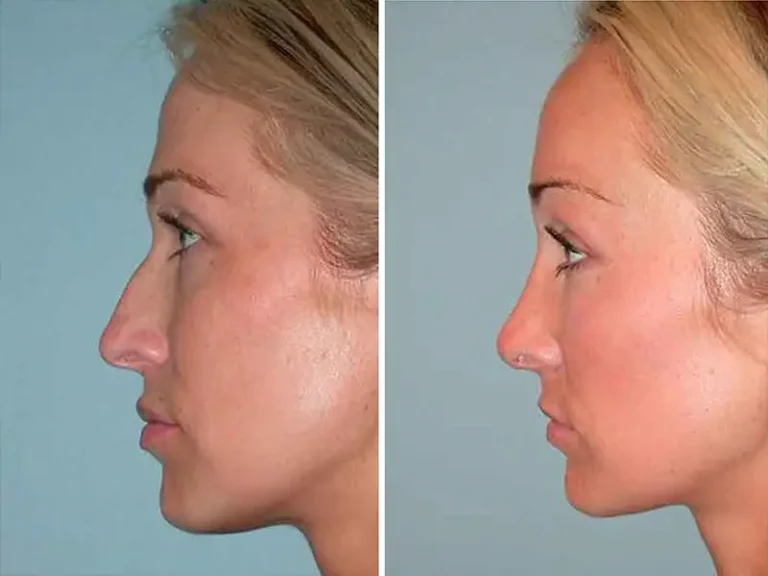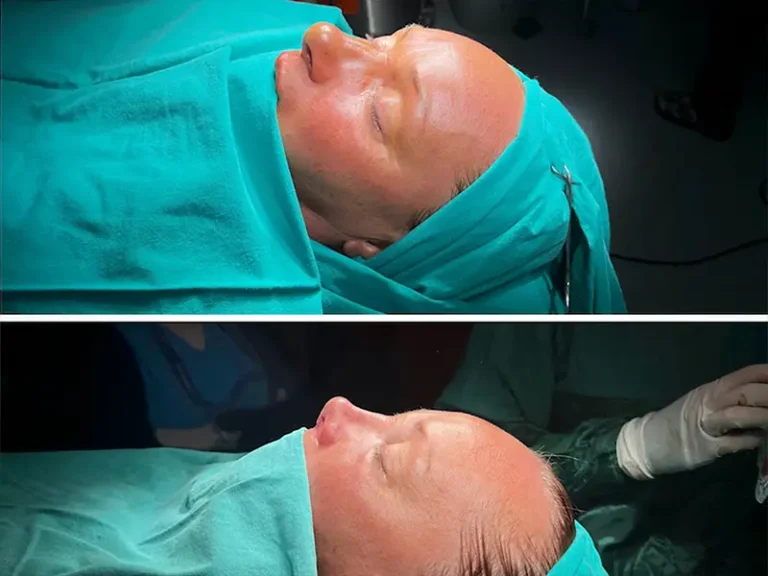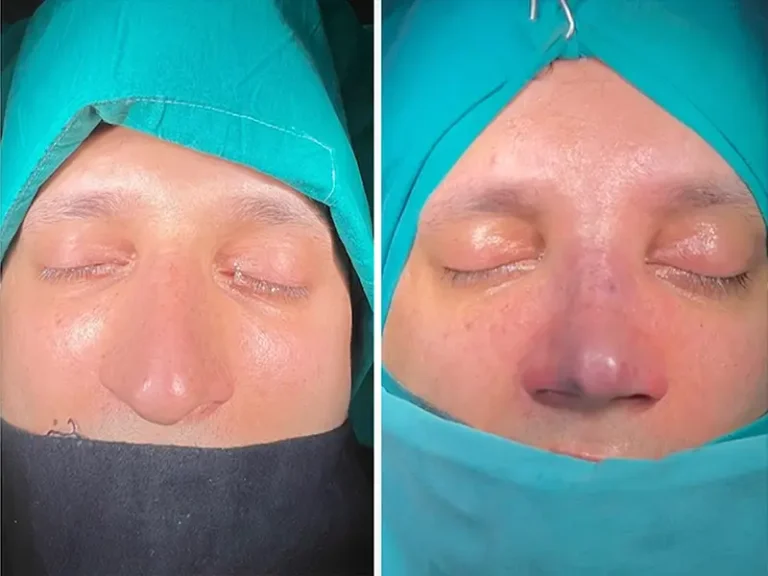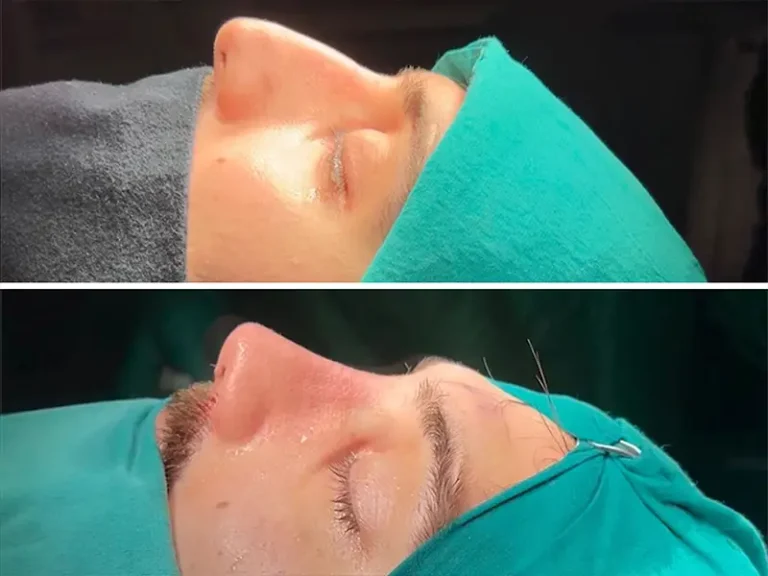Rhinoplasty
Perfect Proportions, Natural Elegance!
What is Rhinoplasty?
Rhinoplasty, commonly known as a nose job, is a surgical procedure that alters the shape of the nose for either cosmetic or functional reasons. It’s one of the most common types of plastic surgery.
Rhinoplasty can change the size, shape, and overall appearance of the nose. It can be performed for aesthetic reasons, such as reshaping the nose’s contour, or for medical reasons, such as correcting breathing problems related to the nose. The procedure can involve modifying the bone, cartilage, skin, or all three.
Get a Free Consultation
Types of Rhinoplasty Procedures
Rhinoplasty, commonly known as a “nose job,” is a surgical procedure designed to reshape or reconstruct the nose for aesthetic or functional purposes. There are several types of rhinoplasty procedures, each tailored to different needs and goals.
Open Rhinoplasty
This technique involves making a small incision on the columella (the strip of skin between the nostrils), allowing full access to the nasal structure. It is ideal for complex cases requiring significant reshaping or structural correction.
Closed Rhinoplasty
In this approach, all incisions are made inside the nostrils, leaving no visible scars. It is commonly used for minor reshaping and has a shorter recovery time compared to open rhinoplasty.
Functional Rhinoplasty
This procedure is performed to improve breathing and correct structural issues such as a deviated septum, nasal valve collapse, or chronic congestion. It is often combined with septoplasty for optimal results.
Revision (Secondary) Rhinoplasty
A corrective procedure for patients who have had a previous rhinoplasty but are dissatisfied with the results or experience breathing issues. It is more complex than primary rhinoplasty due to scar tissue and altered nasal anatomy.
Tip Rhinoplasty
Focused solely on refining the nasal tip, this procedure is suitable for individuals who want to correct a bulbous, asymmetrical, or drooping nasal tip without altering the rest of the nose.
Ultrasonic Rhinoplasty
A modern technique using ultrasonic energy to reshape the nasal bones with precision while minimizing trauma. This leads to less swelling, bruising, and a quicker recovery.
Non-Surgical Rhinoplasty (Liquid Rhinoplasty)
This involves the use of dermal fillers to temporarily reshape the nose without surgery. It is ideal for minor contouring, smoothing out bumps, or lifting the nasal tip, but results are not permanent.
Whether you seek cosmetic enhancement or functional improvement, rhinoplasty can help achieve a balanced, natural-looking result. Consult with a specialist to determine the best approach for your needs!

Non-Surgical Rhinoplasty (Liquid Rhinoplasty)
This involves the use of dermal fillers to temporarily reshape the nose without surgery. It is ideal for minor contouring, smoothing out bumps, or lifting the nasal tip, but results are not permanent.
Whether you seek cosmetic enhancement or functional improvement, rhinoplasty can help achieve a balanced, natural-looking result. Consult with a specialist to determine the best approach for your needs!
Advantages of Rhinoplasty
Rhinoplasty, also known as a “nose job,” is a popular cosmetic and functional procedure that enhances both appearance and breathing function. Whether performed for aesthetic refinement or medical reasons, rhinoplasty offers several key benefits.
- Improved Facial Harmony: A well-proportioned nose enhances overall facial balance, making the features appear more symmetrical and aesthetically pleasing.
- Enhanced Breathing Function: For individuals with a deviated septum, nasal obstruction, or structural issues, rhinoplasty can significantly improve airflow and ease breathing.
- Boosted Self-Confidence: Many people feel more confident and satisfied with their appearance after rhinoplasty, leading to improved self-esteem and social comfort.
- Correction of Birth Defects or Injuries: Rhinoplasty can reconstruct nasal deformities caused by birth defects, trauma, or accidents, restoring both function and appearance.
- Reduction of Snoring & Sleep Issues: By improving nasal airflow, rhinoplasty can help reduce snoring and symptoms of sleep apnea, leading to better sleep quality.
- Customizable Results: Every rhinoplasty is tailored to the patient’s unique needs, whether they seek minor reshaping, tip refinement, or structural corrections.
- Permanent & Natural-Looking Results: Unlike temporary treatments, rhinoplasty provides long-lasting results that enhance natural beauty without looking artificial.
- Can Be Combined with Other Procedures: Rhinoplasty can be performed alongside chin augmentation, facelifts, or non-surgical treatments to achieve balanced facial aesthetics.
Recovery After Rhinoplasty: What to Expect
Rhinoplasty recovery is a gradual process that requires patience and proper care. While initial healing occurs within a few weeks, full results may take up to a year to develop. Here’s what to expect during the recovery journey:
First 24-48 Hours: Immediate Post-Surgery Period
- Swelling, bruising, and mild discomfort are common.
- Patients should rest with their head elevated to minimize swelling.
- Ice packs can help reduce bruising and discomfort.
- Some bleeding and nasal congestion are normal.
First Week: Splint Removal & Initial Healing
- A nasal splint is usually worn for about 5-7 days to protect the nose.
- Most bruising and swelling start to subside.
- Patients should avoid strenuous activities and facial movements that could put pressure on the nose.
2-4 Weeks: Returning to Normal Activities
- Swelling gradually decreases, but some mild puffiness may remain.
- Light activities can be resumed, but heavy exercise should still be avoided.
- Patients should avoid wearing glasses directly on the nose.
1-3 Months: More Noticeable Improvements
- Most swelling has resolved, revealing better definition.
- Breathing improvements become more noticeable, especially in functional rhinoplasty cases.
- Numbness around the nose may persist but will improve over time.
6-12 Months: Final Results
- The nose continues to refine and take its final shape.
- Minor residual swelling, particularly at the tip, fully disappears.
- Patients can enjoy their permanent, natural-looking results.
Tips for a Smooth Recovery
- Follow your surgeon’s post-operative instructions carefully.
- Avoid smoking and alcohol, as they can delay healing.
- Stay hydrated and eat a balanced diet to support recovery.
- Avoid direct sun exposure to prevent discoloration and irritation.
- Be patient—rhinoplasty results take time to fully settle!
Risks of Rhinoplasty: What You Should Know
Rhinoplasty is a safe and effective procedure when performed by an experienced surgeon, but like any surgery, it carries some risks. Understanding these potential risks can help patients make an informed decision.
- Swelling & Bruising: Temporary swelling and bruising around the nose and eyes are common. Most swelling subsides within a few weeks, but minor residual swelling can last up to a year.
- Nasal Obstruction or Breathing Issues: Some patients may experience temporary nasal congestion. In rare cases, improper healing can lead to long-term breathing difficulties.
- Infection: Although rare, infections can occur, requiring antibiotics or additional treatment. Proper post-operative care reduces the risk of infection.
- Bleeding: Mild bleeding is normal in the first few days. Excessive bleeding is rare but requires medical attention.
- Scarring: In closed rhinoplasty, scars are hidden inside the nostrils. In open rhinoplasty, a small scar may form on the columella, but it usually fades over time.
- Numbness or Sensation Changes: Temporary numbness around the nose and upper lip is common. Sensation usually returns within a few months.
- Asymmetry or Unsatisfactory Results: The nose may not heal exactly as expected, leading to minor asymmetry. In some cases, revision rhinoplasty may be needed to refine results.
- Long Healing Process: Rhinoplasty results take time to fully settle—final results may take up to a year. Patients should be patient and follow post-operative care instructions.
How to Minimize Risks
- Choose an experienced and board-certified plastic surgeon.
- Follow all post-operative instructions carefully.
- Avoid smoking and alcohol, which can slow healing.
- Be realistic about expectations and understand that perfect symmetry is not always achievable.

Rhinoplasty in Turkey
Turkey has become one of the top destinations for rhinoplasty (nose job), attracting thousands of international patients each year. With world-class surgeons, cutting-edge technology, and affordable pricing, Turkey offers high-quality rhinoplasty procedures tailored to each patient’s needs.
Why Choose Turkey for Rhinoplasty?
Highly Skilled & Experienced Surgeons
- Turkish plastic surgeons are internationally recognized for their expertise in rhinoplasty.
- Many have trained and practiced in leading medical institutions worldwide.
Advanced Medical Facilities
- Accredited hospitals and clinics use state-of-the-art technology.
- Fully equipped operating rooms ensure safe and successful procedures.
Affordable & Cost-Effective
- Rhinoplasty in Turkey is 50-70% more affordable compared to the US and Europe.
- Prices typically include surgery, consultation, accommodation, and post-op care.
Natural & Customized Results
- Surgeons in Turkey focus on achieving natural-looking results that enhance facial harmony.
- Procedures are tailored to each patient’s unique facial structure and aesthetic goals.
Comprehensive Medical Tourism Packages
Many clinics offer all-inclusive packages, covering:
- VIP airport transfers
- 5-star hotel stays
- Pre- and post-op consultations
- Personalized aftercare services
Short Recovery & Tourist-Friendly Destination
- Patients can enjoy a comfortable recovery while exploring Istanbul, Antalya, or other beautiful cities.
- Many clinics offer follow-up care even after patients return home.
Types of Rhinoplasty Procedures Available in Turkey
- Open & Closed Rhinoplasty – Depending on the complexity of the case.
- Ultrasonic Rhinoplasty – A modern technique for precise reshaping with minimal bruising.
- Revision Rhinoplasty – For patients who need corrections from a previous nose job.
- Tip Rhinoplasty – Focused on refining the nasal tip.
- Functional Rhinoplasty – To improve breathing and correct nasal obstructions.
- Non-Surgical Rhinoplasty – Using dermal fillers for minor reshaping.
Who is a Good Candidate for Rhinoplasty in Turkey?
- Individuals who want to enhance their nose shape or correct breathing issues.
- Those seeking high-quality surgery at an affordable cost.
- People comfortable traveling for medical procedures with a well-planned recovery period.
Frequently Asked Questions
The surgery typically lasts between 1 to 3 hours, depending on the complexity of the case.
- First week: Swelling and bruising are most noticeable; the nasal splint is removed after 7 days.
- 2-4 weeks: Most visible swelling subsides, and normal activities can be resumed.
- 3-6 months: The nose continues to heal and refine in shape.
- Up to 1 year: Final results are fully visible as swelling completely disappears.
- Closed rhinoplasty leaves no visible scars since incisions are made inside the nostrils.
- Open rhinoplasty may leave a small, barely noticeable scar on the columella, which fades over time.
Most patients experience mild to moderate discomfort rather than pain. Swelling and congestion are the most common post-op symptoms. Pain medication is prescribed to manage discomfort during the first few days.
Yes, the results of rhinoplasty are permanent, but the final shape of the nose may take up to a year to fully develop. Aging and lifestyle factors may slightly alter the nose’s appearance over time.
Like any surgery, rhinoplasty has potential risks, including:
- Swelling, bruising, or prolonged healing.
- Nasal asymmetry or unsatisfactory results.
- Temporary breathing difficulties.
- Infection or excessive bleeding (rare).
- Choosing an experienced surgeon minimizes risks and ensures the best outcome.
Holiday & Treatment
You can reach us anytime by phone or send us a message on WhatsApp. We’re happy to assist you!
Book Your Treatment Now








